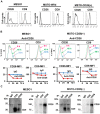CD9 negatively regulates CD26 expression and inhibits CD26-mediated enhancement of invasive potential of malignant mesothelioma cells
- PMID: 24466195
- PMCID: PMC3900581
- DOI: 10.1371/journal.pone.0086671
CD9 negatively regulates CD26 expression and inhibits CD26-mediated enhancement of invasive potential of malignant mesothelioma cells
Abstract
CD26/dipeptidyl peptidase IV is a cell surface glycoprotein which consists of multiple functional domains beside its ectopeptidase site. A growing body of evidence indicates that elevated expression of CD26 correlates with disease aggressiveness and invasive potential of selected malignancies. To further explore the molecular mechanisms involved in this clinical behavior, our current work focused on the interaction between CD26 and CD9, which were recently identified as novel markers for cancer stem cells in malignant mesothelioma. We found that CD26 and CD9 co-modulated and co-precipitated with each other in the malignant mesothelioma cell lines ACC-MESO1 and MSTO-211H. SiRNA study revealed that depletion of CD26 led to increased CD9 expression, while depletion of CD9 resulted in increased CD26 expression. Consistent with these findings was the fact that gene transfer of CD26 into CD26-negative MSTO-211H cells reduced CD9 expression. Cell invasion assay showed that overexpression of CD26 or gene depletion of CD9 led to enhanced invasiveness, while CD26 gene depletion resulted in reduced invasive potential. Furthermore, our work suggested that this enhanced invasiveness may be partly mediated by α5β1 integrin, since co-precipitation studies demonstrated an association between CD26 and α5β1 integrin. Finally, gene depletion of CD9 resulted in elevated protein levels and tyrosine phosphorylation of FAK and Cas-L, which are downstream of β1 integrin, while depletion of CD26 led to a reduction in the levels of these molecules. Collectively, our findings suggest that CD26 potentiates tumor cell invasion through its interaction with α5β1 integrin, and CD9 negatively regulates tumor cell invasion by reducing the level of CD26-α5β1 integrin complex through an inverse correlation between CD9 and CD26 expression. Our results also suggest that CD26 and CD9 serve as potential biomarkers as well as promising molecular targets for novel therapeutic approaches in malignant mesothelioma and other malignancies.
Conflict of interest statement
Figures







References
-
- Ismail-Khan R, Robinson LA, Williams CC Jr, Garrett CR, Bepler G, et al. (2006) Malignant pleural mesothelioma: a comprehensive review. Cancer Control 13: 255–263. - PubMed
-
- Robinson BW, Lake RA (2005) Advances in malignant mesothelioma. N Engl J Med 353: 1591–1603. - PubMed
-
- Morimoto C, Schlossman SF (1998) The structure and function of CD26 in the T-cell immune response. Immunol Rev 161: 55–70. - PubMed
-
- Kameoka J, Tanaka T, Nojima Y, Schlossman SF, Morimoto C (1993) Direct association of adenosine deaminase with a T cell activation antigen, CD26. Science 261: 466–469. - PubMed
Publication types
MeSH terms
Substances
LinkOut - more resources
Full Text Sources
Other Literature Sources
Medical
Molecular Biology Databases
Research Materials
Miscellaneous

